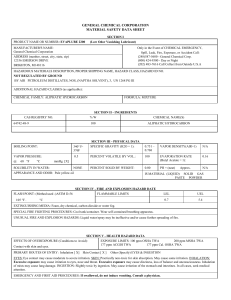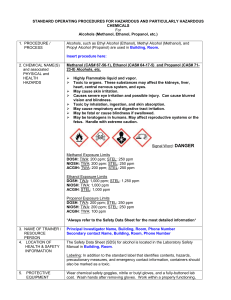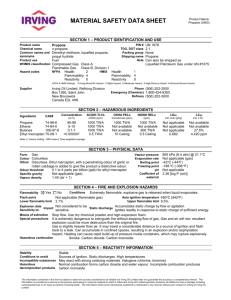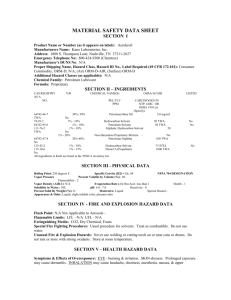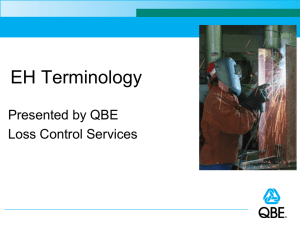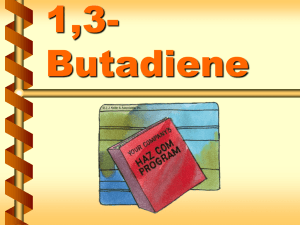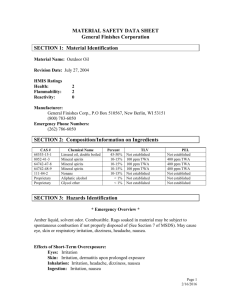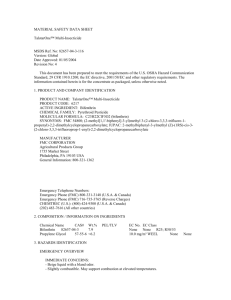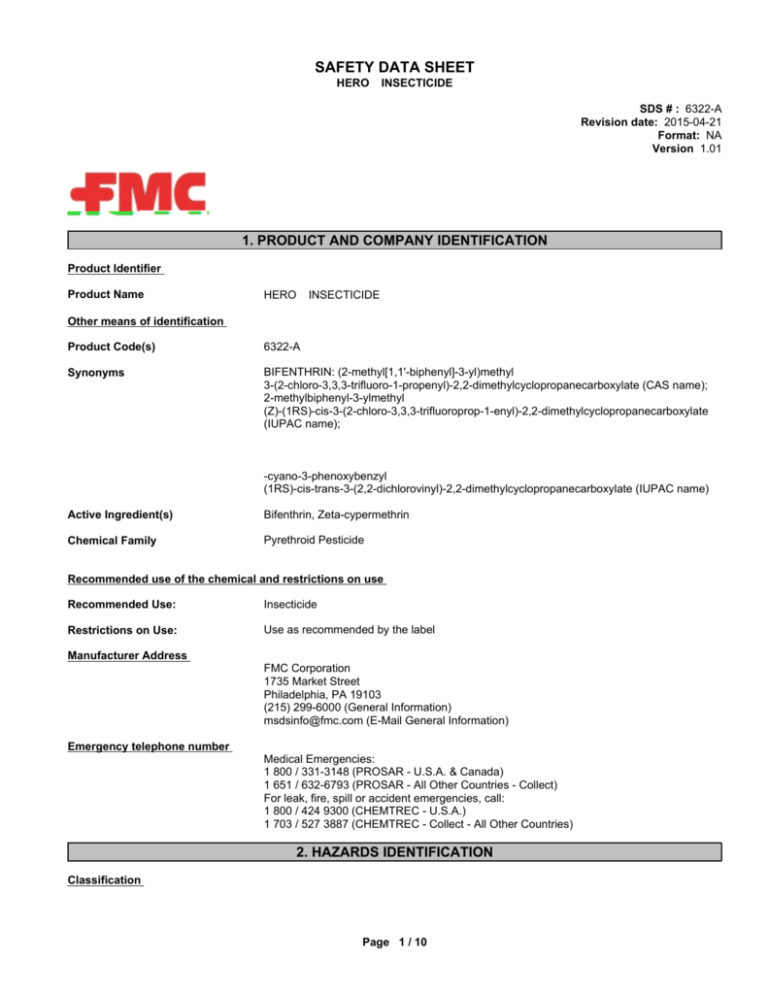
SAFETY DATA SHEET
HERO
INSECTICIDE
SDS # : 6322-A
Revision date: 2015-04-21
Format: NA
Version 1.01
1. PRODUCT AND COMPANY IDENTIFICATION
Product Identifier
Product Name
HERO
INSECTICIDE
Other means of identification
Product Code(s)
6322-A
Synonyms
BIFENTHRIN: (2-methyl[1,1'-biphenyl]-3-yl)methyl
3-(2-chloro-3,3,3-trifluoro-1-propenyl)-2,2-dimethylcyclopropanecarboxylate (CAS name);
2-methylbiphenyl-3-ylmethyl
(Z)-(1RS)-cis-3-(2-chloro-3,3,3-trifluoroprop-1-enyl)-2,2-dimethylcyclopropanecarboxylate
(IUPAC name);
-cyano-3-phenoxybenzyl
(1RS)-cis-trans-3-(2,2-dichlorovinyl)-2,2-dimethylcyclopropanecarboxylate (IUPAC name)
Active Ingredient(s)
Bifenthrin, Zeta-cypermethrin
Chemical Family
Pyrethroid Pesticide
Recommended use of the chemical and restrictions on use
Recommended Use:
Insecticide
Restrictions on Use:
Use as recommended by the label
Manufacturer Address
FMC Corporation
1735 Market Street
Philadelphia, PA 19103
(215) 299-6000 (General Information)
msdsinfo@fmc.com (E-Mail General Information)
Emergency telephone number
Medical Emergencies:
1 800 / 331-3148 (PROSAR - U.S.A. & Canada)
1 651 / 632-6793 (PROSAR - All Other Countries - Collect)
For leak, fire, spill or accident emergencies, call:
1 800 / 424 9300 (CHEMTREC - U.S.A.)
1 703 / 527 3887 (CHEMTREC - Collect - All Other Countries)
2. HAZARDS IDENTIFICATION
Classification
Page 1 / 10
HERO
INSECTICIDE
SDS # : 6322-A
Revision date: 2015-04-21
Version 1.01
OSHA Regulatory Status
This material is considered hazardous by the OSHA Hazard Communication Standard (29 CFR 1910.1200)
Acute toxicity - Oral
Acute toxicity - Inhalation (Dusts/Mists)
Skin sensitization
Carcinogenicity
Specific target organ toxicity (single exposure)
Specific target organ toxicity (repeated exposure)
Aspiration toxicity
Category 4
Category 4
Category 1
Category 2
Category 1
Category 1
Category 1
GHS Label elements, including precautionary statements
EMERGENCY OVERVIEW
Danger
Hazard Statements
H302 - Harmful if swallowed
H304 - May be fatal if swallowed and enters airways
H317 - May cause an allergic skin reaction
H332 - Harmful if inhaled
H351 - Suspected of causing cancer
H370 - Causes damage to organs
H372 - Causes damage to organs through prolonged or repeated exposure
Precautionary Statements - Prevention
P201 - Obtain special instructions before use
P202 - Do not handle until all safety precautions have been read and understood
P281 - Use personal protective equipment as required
P260 - Do not breathe dust/fume/gas/mist/vapors/spray
P264 - Wash face, hands and any exposed skin thoroughly after handling
P270 - Do not eat, drink or smoke when using this product
P271 - Use only outdoors or in a well-ventilated area
P272 - Contaminated work clothing should not be allowed out of the workplace
P280 - Wear protective gloves
Precautionary Statements - Response
P308 + P311 - IF exposed or concerned: Call a POISON CENTER or doctor
P302 + P352 - IF ON SKIN: Wash with plenty of water and soap
P333 + P313 - If skin irritation or rash occurs: Get medical advice/ attention
P363 - Wash contaminated clothing before reuse
P304 + P340 - IF INHALED: Remove person to fresh air and keep comfortable for breathing
P312 - Call a POISON CENTER or doctor if you feel unwell
P301 + P310 - IF SWALLOWED: Immediately call a POISON CENTER or doctor
P331 - Do NOT induce vomiting
P330 - Rinse mouth
Precautionary Statements - Storage
P405 - Store locked up
Precautionary Statements - Disposal
P501 - Dispose of contents/ container to an approved waste disposal plant
Hazards not otherwise classified (HNOC)
Page 2 / 10
HERO
INSECTICIDE
SDS # : 6322-A
Revision date: 2015-04-21
Version 1.01
No hazards not otherwise classified were identified.
Other Information
Very toxic to aquatic life with long lasting effects
3. COMPOSITION/INFORMATION ON INGREDIENTS
Chemical Family
Pyrethroid Pesticide.
Chemical name
Bifenthrin
Zeta-cypermethrin (F2700)
Naphtha (petroleum), heavy aromatic
Petroleum distillates, solvent dewaxed light
paraffinic
2-Methylnaphthalene
Naphthalene
1-Methylnaphthalene
Petroleum distillates, solvent dewaxed heavy
paraffinic
CAS-No
82657-04-3
52315-07-8
64742-94-5
64742-56-9
Weight %
11.25
3.75
40-50
15-25
91-57-6
91-20-3
90-12-0
64742-65-0
10-20
5-10
5-10
1-10
Synonyms are provided in Section 1.
4. FIRST AID MEASURES
Eye Contact
Hold eyes open and rinse slowly and gently with water for 15 to 20 minutes. Remove
contact lenses, if present, after the first 5 minutes, then continue rinsing eye. Call a poison
control center or doctor for further treatment advice.
Skin Contact
Take off contaminated clothing. Rinse skin immediately with plenty of water for 15-20
minutes. Call a poison control center or doctor for further treatment advice.
Inhalation
Move to fresh air. If person is not breathing, call 911 or an ambulance, then give artificial
respiration, preferably mouth-to-mouth if possible. Call a poison control center or doctor for
further treatment advice.
Ingestion
Immediately call a poison control center or doctor Do not induce vomiting unless told to do
so by a poison control center or doctor Do not give any liquid to the person Do not induce
vomiting or give anything by mouth to an unconscious person
Most important symptoms and
effects, both acute and delayed
Central nervous system effects. Allergic skin reactions.
Indication of immediate medical
attention and special treatment
needed, if necessary
Contains petroleum distillate. Vomiting may cause aspiration pneumonia. This product is a
pyrethroid. If large amounts have been ingested, the stomach and intestines should be
evacuated. Treatment is symptomatic and supportive. Digestible fats, oils, or alcohol may
increase absorption and so should be avoided.
5. FIRE-FIGHTING MEASURES
Suitable Extinguishing Media
Foam. Carbon dioxide (CO2). Dry chemical. Water spray or fog.
Specific Hazards Arising from the
Chemical
Hazardous Combustion Products
Carbon oxides (COx), Hydrogen chloride, Hydrogen fluoride.
Explosion data
Sensitivity to Mechanical Impact
Sensitivity to Static Discharge
Not sensitive.
Not sensitive.
Page 3 / 10
HERO
INSECTICIDE
Protective equipment and
precautions for firefighters
SDS # : 6322-A
Revision date: 2015-04-21
Version 1.01
As in any fire, wear self-contained breathing apparatus and full protective gear. Isolate fire
area. Evaluate downwind.
6. ACCIDENTAL RELEASE MEASURES
Personal Precautions
Isolate and post spill area. Remove all sources of ignition. Wear suitable protective clothing,
gloves and eye/face protection. For personal protection see section 8.
Other
For further clean-up instructions, call FMC Emergency Hotline number listed in Section 1
"Product and Company Identification" above.
Environmental Precautions
See Section 12 for additional Ecological Information.
Methods for Containment
Dike to prevent runoff. Absorb with earth, sand or other non-combustible material and
transfer to containers for later disposal.
Methods for cleaning up
Clean and neutralize spill area, tools and equipment by washing with bleach water and
soap. Absorb rinsate and add to the collected waste. Waste must be classified and labeled
prior to recycling or disposal. Dispose of waste as indicated in Section 13.
7. HANDLING AND STORAGE
Handling
Do not contaminate other pesticides, fertilizers, water, food, or feed by storage or disposal.
Storage
Keep in a dry, cool and well-ventilated place. Keep away from open flames, hot surfaces
and sources of ignition. Keep out of reach of children and animals. Keep/store only in
original container.
Incompatible products
None known
8. EXPOSURE CONTROLS/PERSONAL PROTECTION
Control parameters
Chemical name
2-Methylnaphthalene
91-57-6
Naphthalene
91-20-3
ACGIH TLV
S*
TWA: 0.5 ppm
S*
TWA: 10 ppm
1-Methylnaphthalene
90-12-0
Chemical name
2-Methylnaphthalene
91-57-6
Naphthalene
91-20-3
S*
TWA: 0.5 ppm
British Columbia
TWA: 0.5 ppm
Skin
TWA: 10 ppm
STEL: 15 ppm
Skin
1-Methylnaphthalene
TWA: 0.5 ppm
90-12-0
Skin
Appropriate engineering controls
Engineering measures
OSHA PEL
-
NIOSH
-
Mexico
-
TWA: 10 ppm
TWA: 50 mg/m3
IDLH: 250 ppm
TWA: 10 ppm
TWA: 50 mg/m3
STEL: 15 ppm
STEL: 75 mg/m3
-
Mexico: TWA 10 ppm
Mexico: TWA 50 mg/m3
Mexico: STEL 15 ppm
Mexico: STEL 75 mg/m3
Ontario TWAEV
TWA: 0.5 ppm
Skin
TWA: 10 ppm
STEL: 15 ppm
Skin
Alberta
-
Quebec
TWA: 10 ppm
TWA: 52 mg/m3
STEL: 15 ppm
STEL: 79 mg/m3
-
TWA: 0.5 ppm
Skin
-
TWA: 10 ppm
TWA: 52 mg/m3
STEL: 15 ppm
STEL: 79 mg/m3
Skin
-
Apply technical measures to comply with the occupational exposure limits. When working in
confined spaces (tanks, containers, etc.), ensure that there is a supply of air suitable for
breathing and wear the recommended equipment.
Page 4 / 10
HERO
INSECTICIDE
SDS # : 6322-A
Revision date: 2015-04-21
Version 1.01
Individual protection measures, such as personal protective equipment
Eye/Face Protection
For dust, splash, mist or spray exposure, wear chemical protective goggles.
Skin and Body Protection
Wear long-sleeved shirt, long pants, socks, shoes, chemical-resistant gloves and headgear.
Hand Protection
Protective gloves
Respiratory Protection
For dust, splash, mist or spray exposures wear full-face elastomeric half mask respirator
with appropriate cartridges and/or filters, which is approved for pesticides (U.S.
NIOSH/MSHA, EU CEN or comparable certification organization).
Hygiene measures
Clean water should be available for washing in case of eye or skin contamination. Wash
skin prior to eating, drinking, chewing gum or using tobacco. Shower or bathe at the end of
working. Remove and wash contaminated clothing before re-use. Launder work clothing
separately from regular household laundry.
General information
If the product is used in mixtures, it is recommended that you contact the appropriate
protective equipment suppliers These recommendations apply to the product as supplied
9. PHYSICAL AND CHEMICAL PROPERTIES
Information on basic physical and chemical properties
Appearance
Physical State
Color
Odor
Odor threshold
pH
Melting point/freezing point
Boiling Point/Range
Flash point
Evaporation Rate
Flammability (solid, gas)
Flammability Limit in Air
Upper flammability limit:
Lower flammability limit:
Vapor pressure
Vapor density
Density
Specific gravity
Water solubility
Solubility in other solvents
Partition coefficient
Autoignition temperature
Decomposition temperature
Viscosity, kinematic
Viscosity, dynamic
Explosive properties
Oxidizing properties
Molecular weight
Amber, liquid
Liquid
Amber
Hydrocarbon-like
No information available
4.2 (1% solution) at 24ºC (75.2ºF)
Not applicable
No information available
110 °C / 230 °F
No information available
No information available
No information available
No information available
No information available
No information available
8.26 lbs/gal (990.4 g/L)
0.9224 @ 20 °C
No information available
No information available
No information available
No information available
No information available
No information available
No information available
No information available
No information available
HERO
INSECTICIDE
SDS # : 6322-A
Revision date: 2015-04-21
Version 1.01
Conditions to avoid
Heat, flames and sparks
Incompatible materials
None known.
Hazardous Decomposition Products Carbon oxides (COx). Hydrogen chloride. Hydrogen fluoride.
11. TOXICOLOGICAL INFORMATION
Product Information
LD50 Oral
LD50 Dermal
LC50 Inhalation
550 mg/kg (rat)
> 5000 mg/kg (rat)
1.8 mg/L (rat) (4-hr)
Serious eye damage/eye irritation
Skin corrosion/irritation
Sensitization
Mild Irritant.
Moderately irritating (rabbit).
Sensitizer.
Information on toxicological effects
Symptoms
Large doses of bifenthrin ingested by laboratory animals produced signs of toxicity including
convulsions, tremors and bloody nasal discharge. Large doses of zeta-cypermethrin,
ingested by laboratory animals, may produce signs of toxicity including tremors,
incoordination, convulsions, staggered gait, and oral discharge.
Delayed and immediate effects as well as chronic effects from short and long-term exposure
Chronic toxicity
Mutagenicity
Carcinogenicity
Neurological effects
Reproductive toxicity
Developmental toxicity
STOT - single exposure
STOT - repeated exposure
Target organ effects
Neurological effects
Aspiration hazard
Chemical name
Petroleum distillates, solvent
dewaxed light paraffinic
64742-56-9
Naphthalene
91-20-3
Petroleum distillates, solvent
dewaxed heavy paraffinic
64742-65-0
Bifenthrin: Long-term exposure caused neurotoxicity (tremors and impaired gait) in the early
exposure in animal studies, but tremors disappeared with continued exposure.
Zeta-cypermethrin: Long-term exposure caused neurotoxicity (body tremors, decreased
motor activity), decreased body weight and increased liver weight.
Bifenthrin, Zeta-cypermethrin: Not genotoxic in laboratory studies.
Bifenthrin: Weak treatment-related response for liver adenocarcinomas and benign bladder
tumors (lesion) in male mice. Cypermethrin caused an increase in benign lung tumors in
mice, but not in rats. EPA has classified cypermethrin as a possible human carcinogen
based on this information, but does not regulate based on its low cancer risk.
Bifenthrin: Causes clinical signs of neurotoxicity (tremors, impaired gait, excessive
salivation) following acute or subchronic exposure. Tremors disappeared with continued
exposure. Zeta-cypermethrin: Causes neurotoxicity (tremors and decreased motor activity)
following acute, subchronic or chronic exposure.
Bifenthrin, Zeta-cypermethrin: No toxicity to reproduction in animal studies.
Bifenthrin, Zeta-cypermethrin: Not teratogenic in animal studies.
Causes damage to organs. See listed target organs below.
Causes damage to organs through prolonged or repeated exposure. See listed target
organs below.
Bifenthrin, Zeta-cypermethrin: Central Nervous System (CNS), blood.
Bifenthrin: Causes clinical signs of neurotoxicity (tremors, impaired gait, excessive
salivation) following acute or subchronic exposure. Tremors disappeared with continued
exposure. Zeta-cypermethrin: Causes neurotoxicity (tremors and decreased motor activity)
following acute, subchronic or chronic exposure.
No information available.
ACGIH
A2
IARC
NTP
OSHA
A3
Group 2B
Reasonably Anticipated
X
A2
Page 6 / 10
HERO
INSECTICIDE
SDS # : 6322-A
Revision date: 2015-04-21
Version 1.01
12. ECOLOGICAL INFORMATION
Ecotoxicity
Bifenthrin (82657-04-3)
Active Ingredient(s)
Bifenthrin
Duration
96 h LC50
72 h EC50
48 h EC50
21 d NOEC
21 d NOEC
Species
Fish
Algae
Crustacea
Fish
Crustacea
Value
0.1
0.822
0.11
0.012
0.0013
Units
µg/L
mg/L
µg/L
µg/L
µg/L
Zeta-cypermethrin (F2700) (52315-07-8)
Active Ingredient(s)
Duration
Zeta-cypermethrin
48 h EC50
96 h LC50
72 h EC50
21 d NOEC
21 d NOEC
Species
Crustacea
Fish
Algae
Crustacea
Fish
Value
0.14
0.69
>1
0.01
0.015
Units
µg/L
µg/L
mg/L
µg/L
µg/L
Persistence and degradability
Bifenthrin: Moderately persistent. Does not readily hydrolyze. Not readily biodegradable.
Zeta-cypermethrin: Non-persistent. Readily hydrolyzed. Not readily biodegradable.
Bioaccumulation
Bifenthrin: The substance has a potential for bioconcentration.
Zeta-cypermethrin: The substance does not have a potential for bioconcentration.
Mobility
Bifenthrin, Zeta-cypermethrin: Immobile, Not expected to reach groundwater.
13. DISPOSAL CONSIDERATIONS
Waste disposal methods
Improper disposal of excess pesticide, spray mixture, or rinsate is prohibited. If these
wastes cannot be disposed of by use according to label instructions, contact appropriate
disposal authorities for guidance.
Contaminated Packaging
Containers must be disposed of in accordance with local, state and federal regulations.
Refer to the product label for container disposal instructions. Do not reuse or refill this
container.
14. TRANSPORT INFORMATION
DOT
UN/ID no
Proper Shipping Name
Hazard class
Packing Group
Reportable Quantity (RQ)
Marine Pollutant
Description
TDG
UN/ID no
Proper Shipping Name
Hazard class
Not regulated for transportation if shipped in Non Bulk packaging. The classification below
pertains to the shipment in Bulk packaging.
UN3082
Environmentally hazardous substance, liquid, n.o.s.
9
III
Naphthalene: RQ = 191 gal (1532 lb)
Zeta-cypermethrin.
UN3082, Environmentally hazardous substance, liquid, n.o.s. (Zeta-cypermethrin), 9, PGIII,
Marine Pollutant
Classification below is only applicable when shipped by vessel and is not applicable when
shipped by road or rail only.
UN3082
Environmentally hazardous substance, liquid, n.o.s.
9
Page 7 / 10
HERO
INSECTICIDE
SDS # : 6322-A
Revision date: 2015-04-21
Version 1.01
III
Zeta-cypermethrin, Bifenthrin.
UN3082, Environmentally hazardous substance, liquid, n.o.s. (Zeta-cypermethrin,
Bifenthrin), 9, PGIII, Marine Pollutant
Packing Group
Marine Pollutant
Description
ICAO/IATA
UN/ID no
Proper Shipping Name
Hazard class
Packing Group
Description
UN3082
Environmentally hazardous substance, liquid, n.o.s.
9
III
UN3082, Environmentally hazardous substance, liquid, n.o.s. (Zeta-cypermethrin,
Bifenthrin), 9, PGIII
IMDG/IMO
UN/ID no
Proper Shipping Name
Hazard class
Packing Group
EmS No.
Marine Pollutant
Description
UN3082
Environmentally hazardous substance, liquid, n.o.s.
9
III
F-A, S-F
Zeta-cypermethrin, Bifenthrin
UN3082, Environmentally hazardous substance, liquid, n.o.s. (Zeta-cypermethrin,
Bifenthrin), 9, PGIII, Marine Pollutant
15. REGULATORY INFORMATION
U.S. Federal Regulations
SARA 313
Section 313 of Title III of the Superfund Amendments and Reauthorization Act of 1986 (SARA). This product contains a chemical
or chemicals which are subject to the reporting requirements of the Act and Title 40 of the Code of Federal Regulations, Part 372:
Chemical name
CAS-No
Weight %
SARA 313 - Threshold
Values %
Bifenthrin - 82657-04-3
82657-04-3
11.25
1.0
Naphthalene - 91-20-3
91-20-3
5-10
0.1
SARA 311/312 Hazard Categories
Acute health hazard
Chronic health hazard
Fire hazard
Sudden release of pressure hazard
Reactive Hazard
Yes
Yes
No
No
No
Clean Water Act
This product contains the following substances which are regulated pollutants pursuant to the Clean Water Act (40 CFR 122.21
and 40 CFR 122.42):
Chemical name
CWA - Reportable
CWA - Toxic Pollutants
CWA - Priority
CWA - Hazardous
Quantities
Pollutants
Substances
Naphthalene
100 lb
X
X
X
91-20-3
CERCLA
This material, as supplied, contains one or more substances regulated as a hazardous substance under the Comprehensive
Environmental Response Compensation and Liability Act (CERCLA) (40 CFR 302):
Chemical name
Hazardous Substances RQs
Naphthalene
91-20-3
100 lb
Extremely Hazardous
Substances RQs
RQ
RQ 100 lb final RQ
RQ 45.4 kg final RQ
FIFRA Information
Page 8 / 10
HERO
INSECTICIDE
SDS # : 6322-A
Revision date: 2015-04-21
Version 1.01
This chemical is a pesticide product registered by the Environmental Protection Agency and is subject to certain labeling
requirements under federal pesticide law. These requirements differ from the classification criteria and hazard information
required for safety data sheets, and for workplace labels of non-pesticide chemicals. Following is the hazard information as
required on the pesticide label:
Caution
Harmful if swallowed, inhaled or absorbed through the skin. Causes moderate eye irritation.
This pesticide is extremely toxic to fish, aquatic invertebrates oysters and shrimp.
US State Regulations
California Proposition 65
This product contains the following Proposition 65 chemicals:.
Chemical name
Naphthalene - 91-20-3
California Prop. 65
Carcinogen
U.S. State Right-to-Know Regulations
Chemical name
Bifenthrin
82657-04-3
Zeta-cypermethrin (F2700)
52315-07-8
Petroleum distillates, solvent
dewaxed light paraffinic
64742-56-9
2-Methylnaphthalene
91-57-6
Naphthalene
91-20-3
1-Methylnaphthalene
90-12-0
New Jersey
X
Massachusetts
Pennsylvania
X
X
X
X
X
X
X
X
X
International Inventories
Component
Bifenthrin
82657-04-3 ( 11.25
)
Zeta-cypermethrin
(F2700)
52315-07-8 ( 3.75 )
Naphtha
(petroleum), heavy
aromatic
64742-94-5 ( 40-50
)
Petroleum
distillates, solvent
dewaxed light
paraffinic
64742-56-9 ( 15-25
)
2-Methylnaphthalen
e
91-57-6 ( 10-20 )
TSCA
(United
States)
DSL
(Canada)
EINECS/ELI
NCS
(Europe)
PICCS
(Philippines)
AICS
(Australia)
X
X
X
ENCS
(Japan)
China
(IECSC)
KECL
(Korea)
X
X
X
X
X
X
X
X
X
X
X
X
X
X
X
X
X
X
X
X
X
X
X
X
X
X
X
X
Page 9 / 10
HERO
INSECTICIDE
Naphthalene
91-20-3 ( 5-10 )
1-Methylnaphthalen
e
90-12-0 ( 5-10 )
Petroleum
distillates, solvent
dewaxed heavy
paraffinic
64742-65-0 ( 1-10
)
X
X
X
X
X
X
X
X
X
X
X
X
X
X
X
Mexico - Grade
Serious risk, Grade 3
WHMIS Hazard Class
D1B - Toxic materials
D2A - Very toxic materials
X
X
SDS # : 6322-A
Revision date: 2015-04-21
Version 1.01
X
X
X
X
X
X
16. OTHER INFORMATION
NFPA
HMIS
Revision date:
Revision note
Health Hazards 3
Health Hazards 2*
Flammability 1
Flammability 1
Instability 0
Physical hazard 0
Special Hazards Personal Protection X
2015-04-21
(M)SDS sections updated
Disclaimer
FMC Corporation believes that the information and recommendations contained herein (including data and statements)
are accurate as of the date hereof. NO WARRANTY OF FITNESS FOR ANY PARTICULAR PURPOSE, WARRANTY OF
MERCHANTABILITY OR ANY OTHER WARRANTY, EXPRESSED OR IMPLIED, IS MADE CONCERNING THE INFORMATION
PROVIDED HEREIN. The information provided herein relates only to the specified product designated and may not be
applicable where such product is used in combination with any other materials or in any process. Use of this product is
regulated by the U.S. Environmental Protection Agency (EPA). It is a violation of Federal law to use this product in a
manner inconsistent with its labeling. Further, since the conditions and methods of use are beyond the control of FMC
Corporation, FMC corporation expressly disclaims any and all liability as to any results obtained or arising from any use
of the products or reliance on such information.
Prepared By:
FMC Logo - Trademark of FMC Corporation
© 2015 FMC Corporation. All Rights Reserved.
End of Safety Data Sheet
Page 10 / 10

